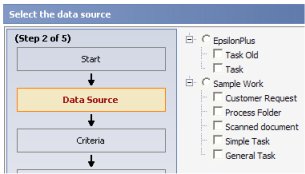|

 In the
DataSource step of the V5 Report Wizard, the user is asked to select
a class (or class group) as the source of instances to include in the
report. GRP-923
In the
DataSource step of the V5 Report Wizard, the user is asked to select
a class (or class group) as the source of instances to include in the
report. GRP-923
By default, this step presents one of six lists of classes.
(Classes are listed by name or by Short Description, depending on a
user choice in the Start step.)
List Name |
reportCategory |
Contents |
| Rules | Rules
|
All rule types, plus the database view accessed by the Data-Rules-Summary class. |
| Monitor Assignments | AssignmentMonitoring
|
Concrete classes derived from the Assign- base class. |
| Monitor Processes | WorkMonitoring
|
Work groups and work types available to this user. |
| Analyze Quality | WorkAnalysis
|
Work groups and work types available to this user. |
| Analyze Performance | PerformanceAnalysis
|
History- classes for the work groups available to this user |
| Data | Data
|
Concrete classes derived from the Data- base class. |
| System | System
|
Concrete classes derived from the System-. Log, and Index- base classes, plus selected History- classes. |
You can customize these lists by overriding a standard activity. For example, you can prevent Report Wizard users from reporting on a specific class of work objects, or a specific class of assignments.
To control the DataSource display of classes:
reportCategory
input parameter has one of the seven values listed in the above table.
(Report category values are defined by field value rules where the
Applies To key part is Rule-Obj-Report-.) Make your
activity produce a Code-Pega-List page with embedded
pxResults() pages each containing two facts about classes
to be listed: pyClassName (the class name) and
pyLabel (the Short Description).The customizations described here affect only the Report Wizard experience. They do not alter the contents of a list view or summary view rule created with the Report Wizard.